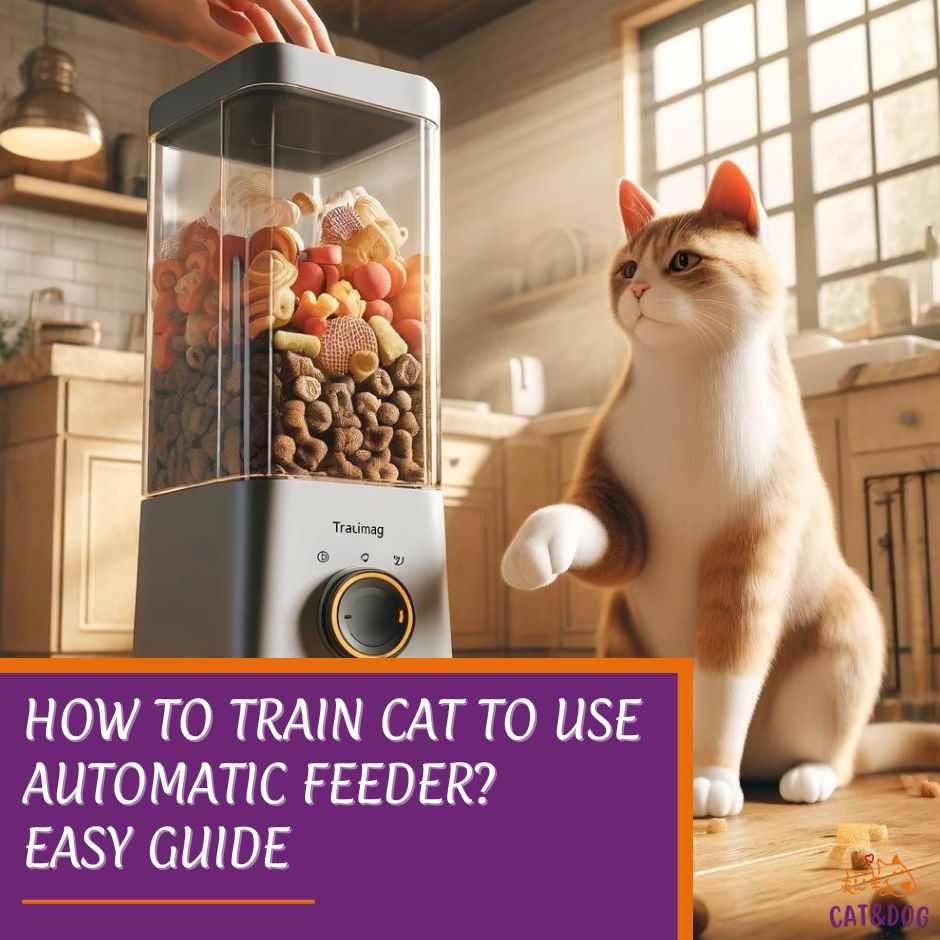Training your feline friend to use an automatic feeder can revolutionize both your life and theirs. It’s a leap into modern cat care that promises convenience and a consistent feeding schedule for your kitty.
Have you ever found yourself in a pinch, unable to get home in time to feed your cat? Or maybe you’re just tired of the early morning wake-up calls? An automatic feeder might just be the gadget you need. (1)
But, how to train cat to use automatic feeder? This question must have crossed your mind.
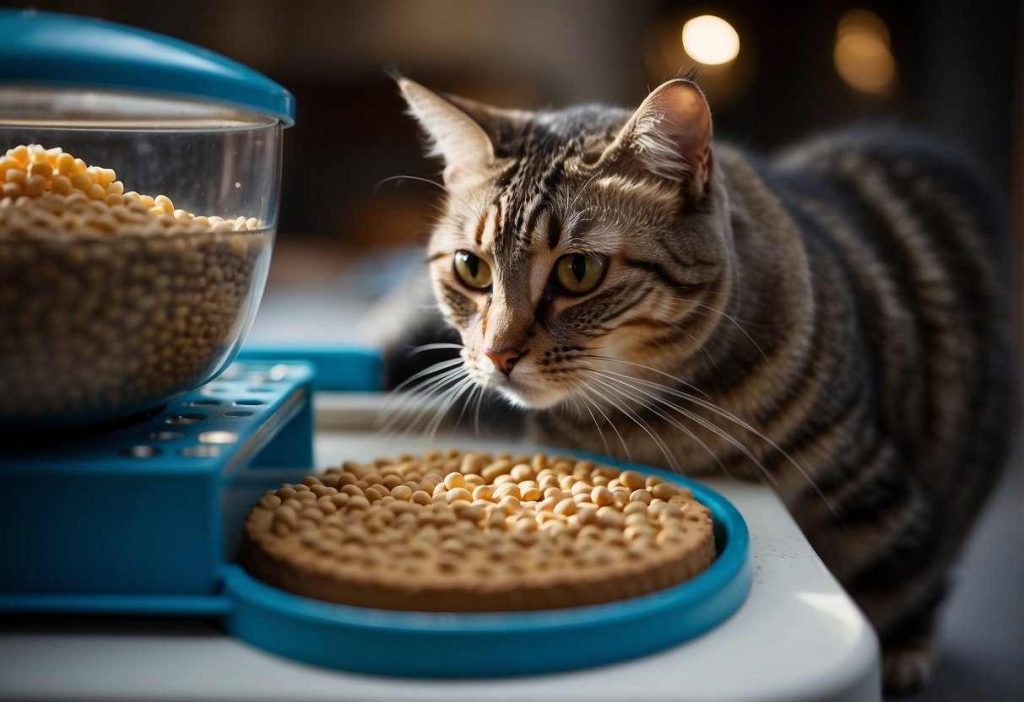
Selecting the right feeder is as important as the training process itself. Automatic feeders come in various designs and functionalities.
Some dispense food at predetermined intervals, while others are triggered by your cat’s microchip or RFID collar. (2)
The diversity in choice means there’s a perfect fit for every feline personality and dietary need, ensuring that your cat is fed on time, every time.
Remember, introducing any new device to your cat requires patience and an understanding of their behavior.
Cats are creatures of habit, so a gradual introduction to the new feeder alongside positive reinforcement can make a world of difference.
Picture the scene: Your cat, once skeptical of the new robotic contraption, now sits patiently, awaiting the next scheduled feast with purrs of anticipatory delight.
Key Takeaways
- Consistent use of an automatic feeder can establish a routine feeding schedule for your cat.
- Selecting a feeder that suits your cat’s needs is crucial for successful adoption.
- Understanding your cat’s behavior is key to a smooth transition to using the feeder.
How to Train Cat to Use Automatic Feeder: Step-by-Step Guide
Introducing the Feeder to Your Cat
Curiosity killed the cat, but it won’t harm yours to get a little curious about their new automatic feeder, right?
The first step is the grand introduction. Simply place the automatic feeder next to your cat’s regular feeding dish without adding food.
You’re giving your furry friend some time to sniff it out and investigate for a day or two. Remember, we’re going for a no-surprises relationship with our gadget.
Establishing a Feeding Routine
Now that your cat isn’t spooked by the new device, it’s time to make it the go-to spot for munchies.
Plan a feeding schedule and stick to it. Begin by placing a small amount of food in the feeder while still using the regular dish.
This routine establishes a link in your cat’s mind between the feeder and mealtime.
Gradual Transition to Exclusive Use of the Feeder
Have your cat tried just a nibble from the automatic feeder yet? It’s now time for a gradual transition. Each day, increase the portion of food in the feeder and decrease what’s put in the old dish.
Gradually, your cat will start associating the feeder with the deliciousness of dinner time. It’s like they say, slow and steady wins the race, or in this case, trains the cat!
Maintaining Consistency and Patience
Consistency is key, not just in what you’re serving but also in the serving size. Keep the amount of food and the feeding times as regular as you can.
Cats are creatures of habit, and a consistent routine will make the training stick. Patience is your best friend here because, let’s be honest, cats do things their own way and in their own time.
Troubleshooting and Maintenance
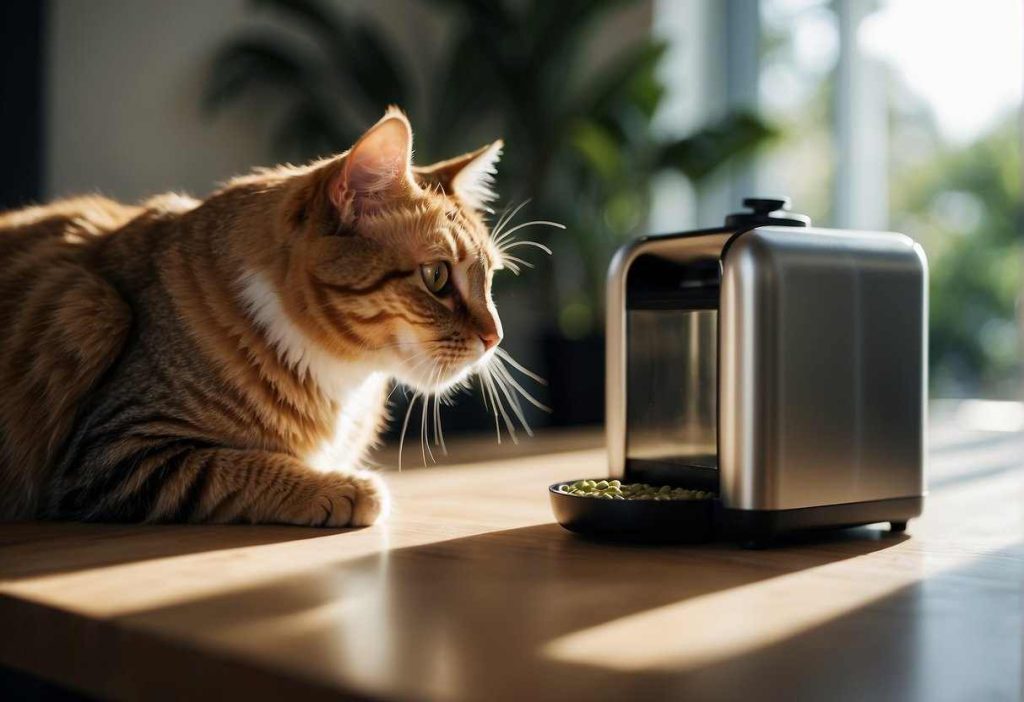
Common Issues and How to Resolve Them:
- Feeder Tampering: Is your clever kitty playing with the feeder like it’s a new toy? If they spill or damage the feeder, you’ll need a quick fix. Sometimes, securing the feeder to a heavy base can prevent knock-overs. Encasing feeders in a protective shell could also deter those mischievous paws!
- Ignoring the Feeder: Some cats are just old-fashioned, or maybe just picky. They may ignore the futuristic contraption altogether. To coax them, place treats in the feeder’s bowl or lead them with their favorite food. Consistency is key—once they get the hang of it, they should be on board.
- Dependency Issues: On the flip side, if your cat has become a bit too fond of the feeder, it’s time for some tough love. Make sure they have set feeding times, to prevent constant snacking.
Keeping Your Automatic Feeder Operational:
Got a fancy feeder? You got this! Regular maintenance will keep things running smoothly.
- Cleaning: Remove any leftover food bits to prevent clogging or spoilage. Most feeders have detachable parts which can be washed easily.
- Maintenance: Regularly check for wear and tear. Replace any broken parts immediately to avoid malfunctions.
- Troubleshooting: Is your feeder not dispensing food? First, check for any blockages. No luck? Review the user manual for troubleshooting steps or contact customer support for your feeder model. They’ll help sort it out.
A well-maintained feeder equals a happy, healthy kitty. And if all else fails, sometimes a little ingenuity goes a long way.
If you get stuck, there’s a whole community of fellow cat lovers and experts willing to lend a hand.
Just remember, you’re in charge—not the machine or your four-legged overlord! Keep things tidy, check in regularly, and your feeder will be a trusty companion in your cat’s daily routine.
Understanding Cat Behavior and Automatic Feeders
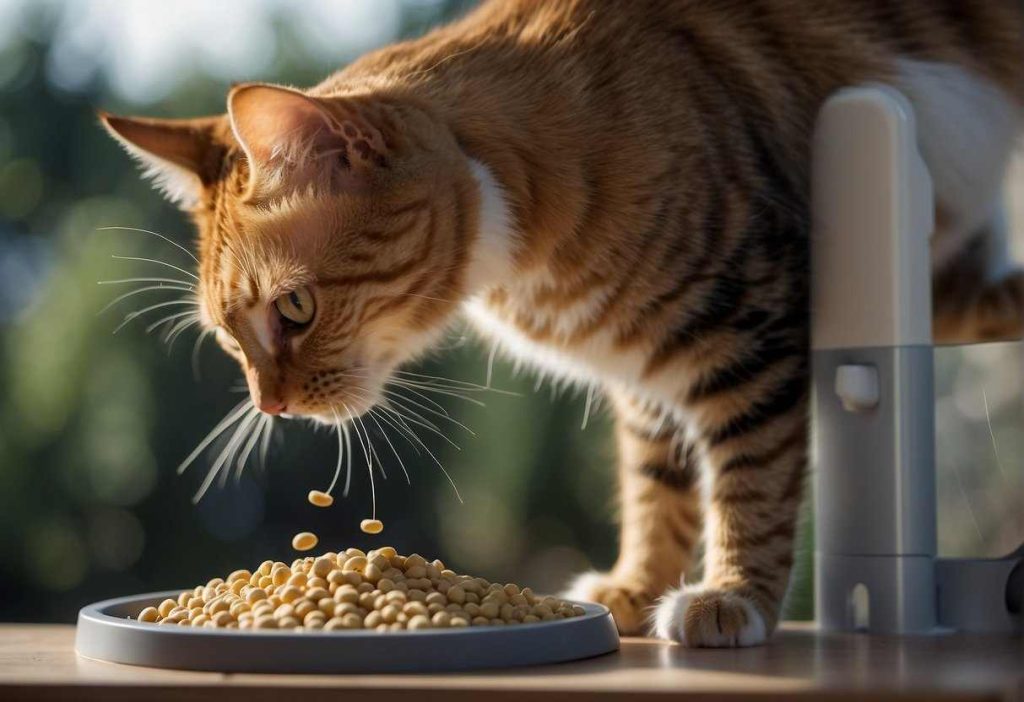
Your cat’s natural feeding behavior is to hunt, which involves periods of fast followed by a feast.
Automatic feeders can play into this instinct by providing small, measured amounts of food throughout the day. It’s like replicating their ancestral dining habits!
Now, let’s talk psychology.
Cats are creatures of habit, right? An automatic feeder might throw them for a loop at first. Your job is to make it a seamless, anxiety-free introduction.
How, you ask?
Start by placing the feeder near your cat’s usual dining spot without removing their regular bowl just yet. This lets your cat snoop around – trust me, they won’t resist the curiosity!
Preparing Your Cat for the Transition
- Maintain your usual feeding routine: Introduce the feeder without changing meal times.
- Use positive reinforcement: Offer treats and affection when your cat approaches the feeder.
- Keep it familiar: Place a bit of their usual food in the feeder to entice them.
Minimizing resistance is all about patience. If your cat is hesitant, don’t fret! They just need time to accept this new gadget.
Imagine seeing a robot for the first time—you’d be wary too, wouldn’t you?
Building Curiosity and Acceptance
- Demonstrate the feeder: Let your cat see and hear it in action.
- Feed alongside the feeder: Gradually reduce the amount in their old bowl.
- Make the feeder appealing: Use their favorite food initially to create a positive association.
Remember, your cat needs to trust the feeder as a food source.
So take it slow, offer lots of cuddles, and you’ll both be on your way to a happier, hassle-free feeding routine!
Selecting the Right Automatic Feeder
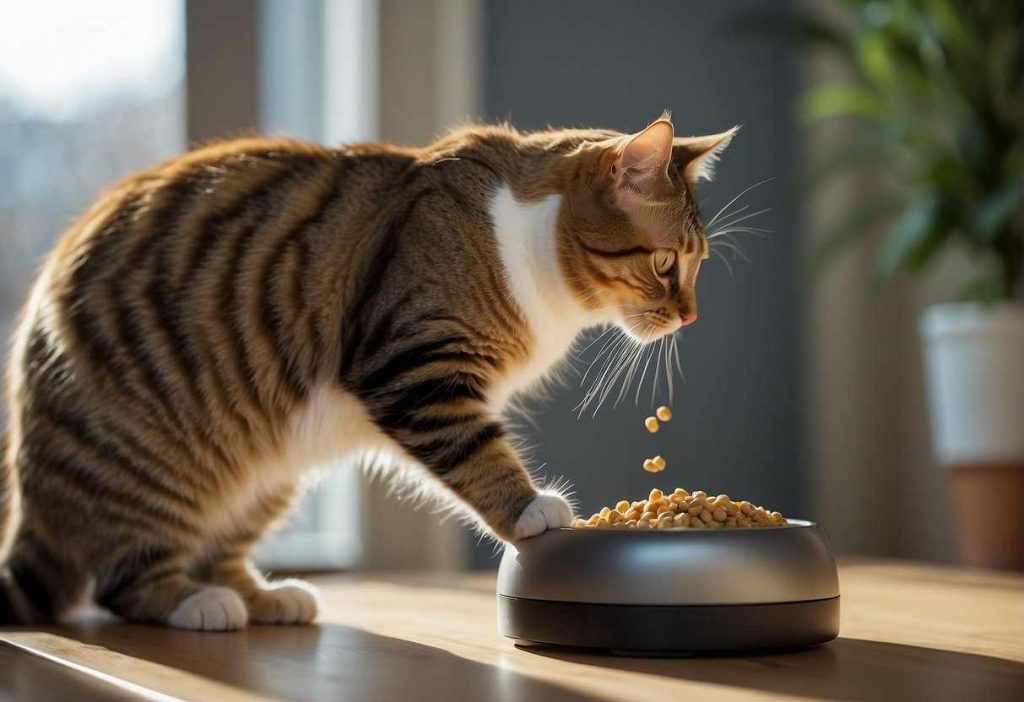
Age, Size, and Health:
- Kittens: Small portions, frequent meals.
- Adults: Standard portion sizes.
- Seniors: Special diet needs; easy access.
- Large Breeds: Larger kibble capacity.
Features can truly make a feeder a hit or a miss. Think about these:
- Programmability: Set it and forget it! Meal times on autopilot.
- Portion Control: Because neither of us need that extra weight, right?
- Battery Life or Power Source: You don’t want the feeder to konk out mid-meal.
- Durability: Cats have that ninja-like prowess to get into things they shouldn’t.
- Ease of Cleaning: Hygiene is crucial, wouldn’t you agree?
The feeding experience should make both you and your whiskered pal happy.
Does Skip have a strong dislike for stale kibble? Then you might want a feeder with a freshness feature.
Finally, ponder over:
- Does it have anti-jamming to keep the kibble flowing smoothly?
- Can it handle your cat’s favorite kibble size?
- The warranty; and safety nets are always a plus, aren’t they?
- Are you looking for extras like camera monitoring or voice recording to call them to eat?
Remember, it’s not just an automatic feeder; it’s peace of mind that your cat is well-fed and content. Happy hunting!
Advanced Feeding Strategies
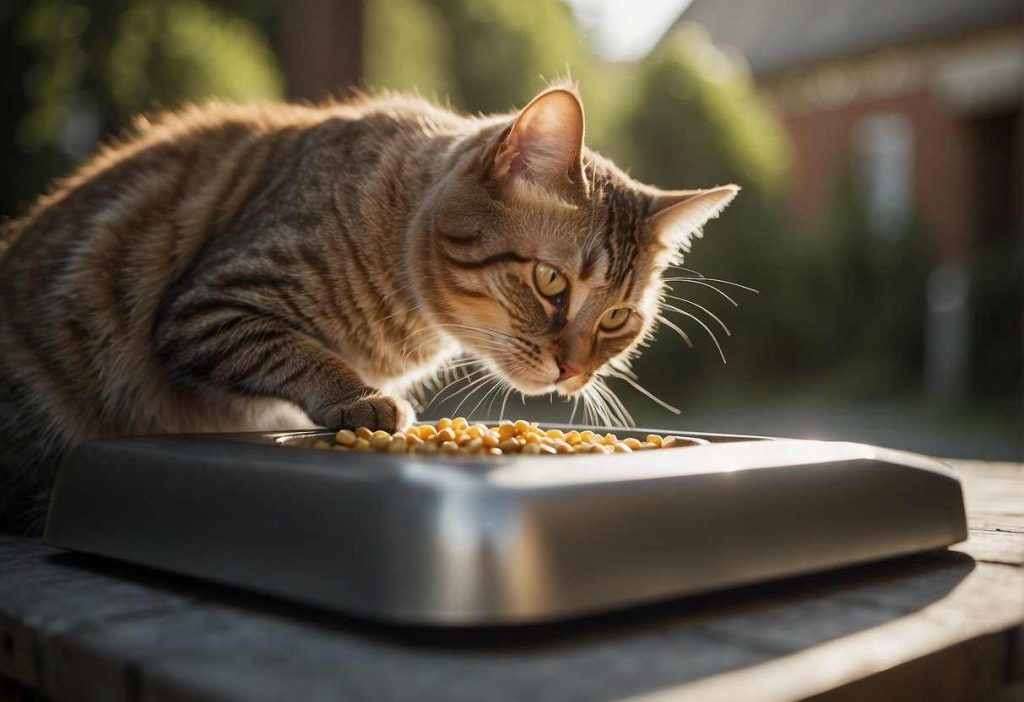
Managing Feeding in Multi-Cat Households:
- Assign specific feeding stations: If you can, try setting up an automatic feeder for each cat. Label them if it helps! (3)
- Use microchip feeders: These gadgets are the James Bond feeders, opening for the right cat’s microchip. Super cool, and no more food thieves!
Now, let’s talk about keeping your cat in tip-top shape.
Do they sometimes act like a little vacuum cleaner, inhaling all their food in one go?
Tailoring Feeding Schedules to Your Cat’s Needs:
- Control portions: Divide the daily amount into smaller, more frequent meals. Use the feeder’s settings for this smart move. (4)
- Set appropriate meal times: You’re the boss, so schedule meals when your cat is most active. It’s like a surprise snack party all day long! (5)
| Feeder Settings | Description |
|---|---|
| Feeding Frequency | Adjust to 3-4 small meals a day |
| Portion Size | Tailor to your cat’s dietary needs |
| Specific Timings | Align with their most active periods |
Remember, it’s not just about filling their bellies; it’s about keeping them healthy, happy, and at a good weight.
Diets are not one-size-fits-all, so adjust that feeder as if you’re a cat nutritionist. Who knew you had it in you, huh?
Ready to roll up your sleeves, and get into the nitty-gritty of cat-feeding diplomacy?
With these tips, soon your cats will be dining in purr-fect harmony.
Happy feeding!
Health Implications and Nutritional Considerations
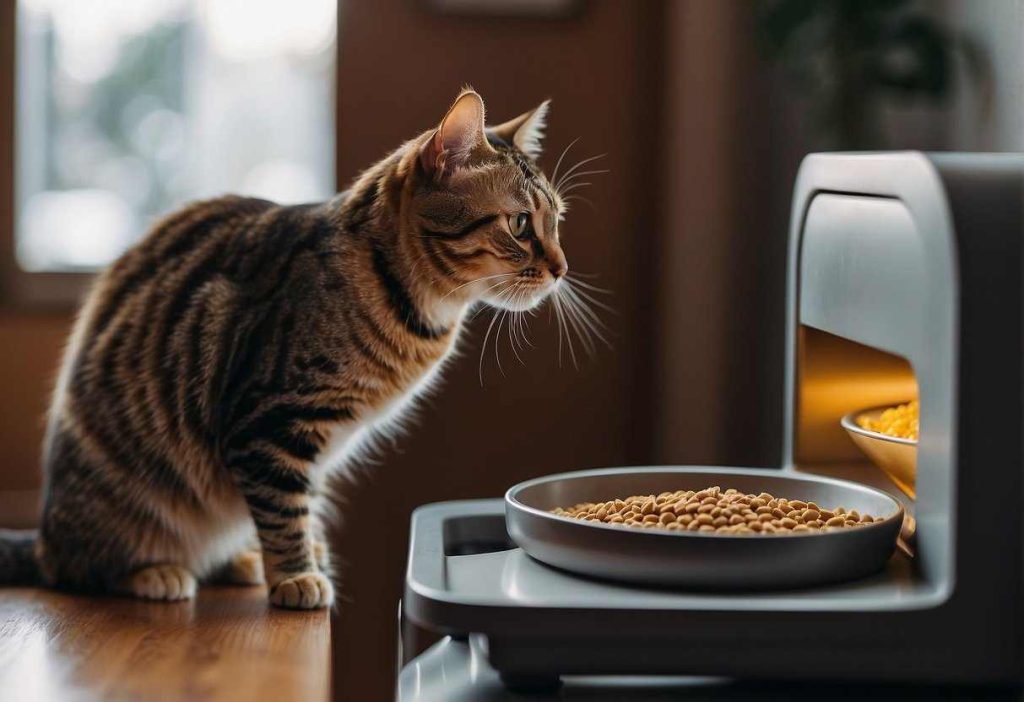
Impact of Timed Feeding on Cat Health
Timed feeding can be a lifesaver, literally!
It has a big impact on preventing obesity—a huge plus since overweight kitties can run into all sorts of trouble. Think diabetes, arthritis, and even heart disease. (6)
But don’t fret! An automatic feeder can be your sidekick in keeping those extra pounds off by doling out just the right amount of food.
| Feeding Schedule Benefits | Details |
|---|---|
| Weight Management | Helps maintain a healthy weight through controlled portions |
| Disease Prevention | Lowers the risk of obesity-related diseases |
Now, isn’t it amazing that something as simple as scheduled mealtimes can do so much?
Adjusting Diet and Portions Over Time
Remember how you change up your wardrobe with the seasons?
Well, it’s just as smart to tweak your cat’s diet over time.
Age, activity level, and even the weather can affect your cat’s nutritional needs. Monitoring their health and adjusting feeding portions can keep your kitty in tip-top condition.
- Kittenhood: Small, frequent meals to fuel growth (7)
- Adulthood: Balanced portions to maintain optimal health
- Senior Status: Possible diet adjustments to manage age-related issues
By keeping an eye on your cat’s needs and making smart, timely changes, you’re setting up a feast for success.
So, why not turn mealtime into a well-oiled machine that keeps your four-legged buddy purring with health?
Your cat—and your peace of mind—will thank you for it!
Enhancing the Human-Cat Bond
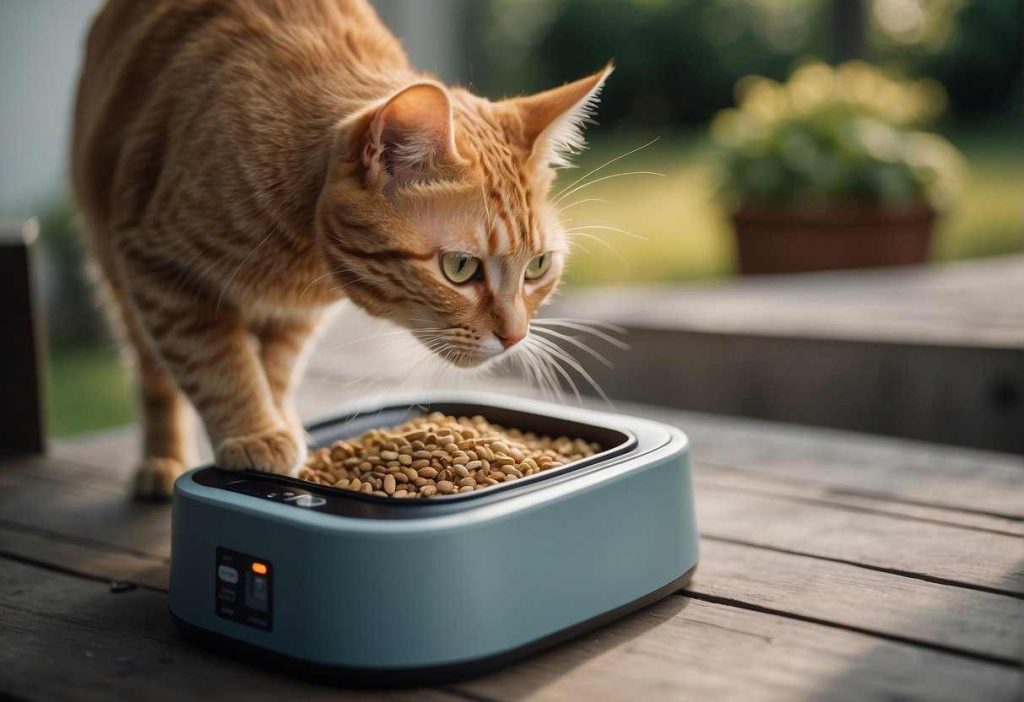
The Emotional Journey of Automatic Feeding
You might worry that your cat will love the machine more than you. Relax! Cats don’t just crave food; they need your love too.
Associating you with mealtime isn’t the only way to maintain that affectionate connection.
Maintaining a Loving Connection and Interaction
- Get Involved: Be there during feeding times at first. Hit the button to dispense the food, and give your cat a reassuring pet or a playful tickle.
- Playtime: Incorporate play sessions. A laser pointer romp or a ribbon chase can reinforce that you’re the source of fun, not just food.
Real-Life Success Stories and Expert Insights
Jane Doe, a long-time cat owner, swears by interaction post-feeding. “Ever since I got the feeder, I follow up with cuddle time. Whiskers have never been happier!”
Animal behaviorists back this up, explaining that routine is key. Stick to a pattern, and your cat will learn that love and attention are always on the schedule.
Testimonials from Cat Owners and Advice from Animal Behaviorists
| Owner’s Name | Cat’s Name | Experience with Automatic Feeder |
|---|---|---|
| John Smith | Paws | “The feeder is great, but it’s our evening snuggle after dinner that Paws waits for!” |
| Emily Jones | Fluffy | “Fluffy used to wake me at 5 AM. Now, she lets me sleep. Our playtime has become our new morning routine!” |
In short, you’re irreplaceable. Mix up your interactions and keep your bond strong.
Remember, the automatic feeder is a tool to ease your life, not to replace the warmth only you can provide.
So, keep on being the amazing cat parent you are – your kitty counts on it!
Quick Recap
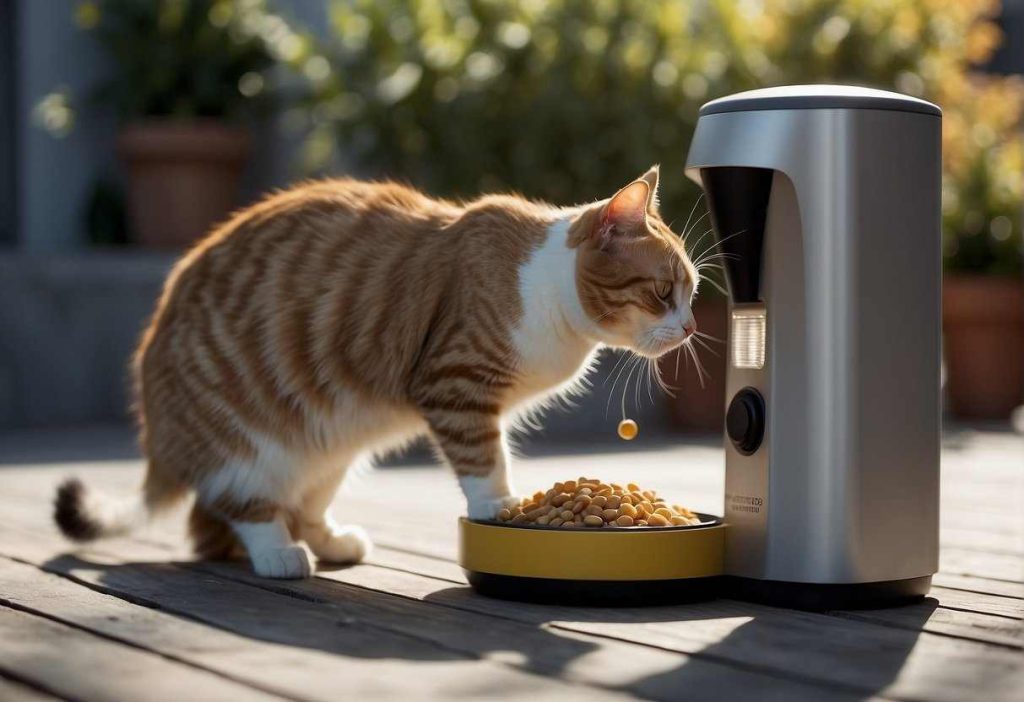
Setting Up the Feeder:
- Choose a quiet spot that your cat already loves.
- Introduce the feeder without power to make it a part of the scenery.
Getting Acquainted:
- Take baby steps by placing treats around and inside the turned-off feeder.
- Celebrate every small win with plenty of treats and pets!
| Phases | Actions | Tips |
|---|---|---|
| Introduction | Unpowered feeder exposure | Keep it calm and stress-free |
| Familiarization | Treats near the feeder | Positive reinforcement |
| Operation | Turn on the feeder for short periods | Gradually increase time |
| Full Transition | Monitor first automatic feeding day | Stay close for support |
Training Progression:
- Turn the feeder on for a minute or two, then back off.
- Gradually increase the powered-on time.
- Observe your cat’s first interaction on full operation day.
Remember, patience is your best pal! You may need a few days or even a couple of weeks.
Feeling excited yet?
Think about the win-win situation ahead: a happier cat with consistent meal times and fewer demands on your schedule.
Keep up the good vibes, you’re both doing paw-some!
Frequently Asked Questions
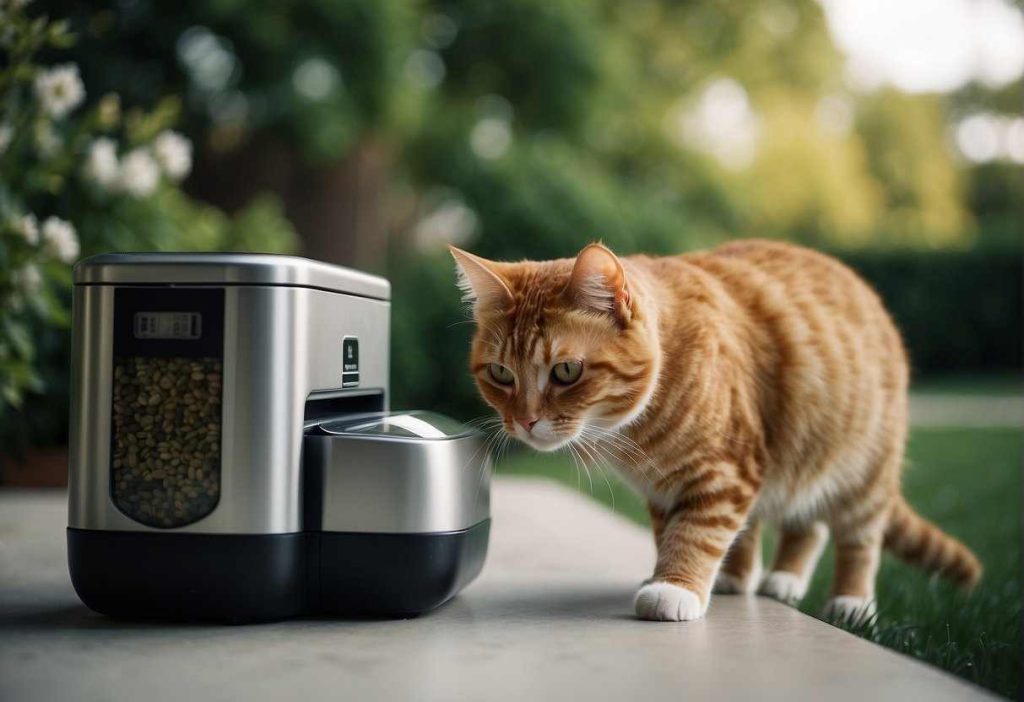
Navigating the world of automatic feeders can be like learning a new tech gadget.
You’ve got questions, and I’ve got the simple, quick answers to help make feeding time a breeze for you and your whiskered companion.
How long does it typically take to train a cat to use an automatic feeder?
It usually takes about 2 to 4 weeks for a cat to get fully comfortable with a new feeding routine using an automatic feeder. Be patient—consistency is key!
What should I do if my cat is afraid of the automatic feeder?
First off, don’t worry—it’s common.
Place the feeder in your cat’s environment without turning it on so they can sniff and explore it.
Gradually introduce the sounds and movements of the feeder to your cat over a few days or weeks.
How do I choose the right size and type of automatic feeder for my cat?
Consider your cat’s size and eating habits. A feeder with a capacity appropriate for your cat’s daily intake is ideal.
Choose between gravity feeders and programmable ones based on your cat’s needs—programmable for precision, and gravity for constant availability.
How can I prevent my cat from being fixated on the automatic feeder?
Keep the feeder out of sight when not in use, or create a feeding schedule that doesn’t let your cat anticipate feedings.
Sometimes, a little distraction like playing can help shift their focus.
What are the benefits and drawbacks of using an automatic feeder for my cat?
Automatic feeders help with precise portion control and maintaining a consistent feeding routine. They’re a win-win for busy pet parents.
However, they may occasionally malfunction, and some cats may attempt to break into them—so quality matters!
Could an automatic feeder help stop my cat from disturbing my sleep in the early hours?
Setting the feeder to provide a meal early in the morning can satisfy your cat’s hunger and let you sleep in—no more paws to the face at dawn!
Are there any strategies to ensure a smooth transition to an automatic feeder for a cat who’s used to traditional feeding?
Yes, indeed!
Start by placing the automatic feeder next to the cat’s current dish. Keep the manual dish present but empty, so your feline friend associates the feeder with food.
Gradually phase out the old dish as your cat adapts to the new routine.

